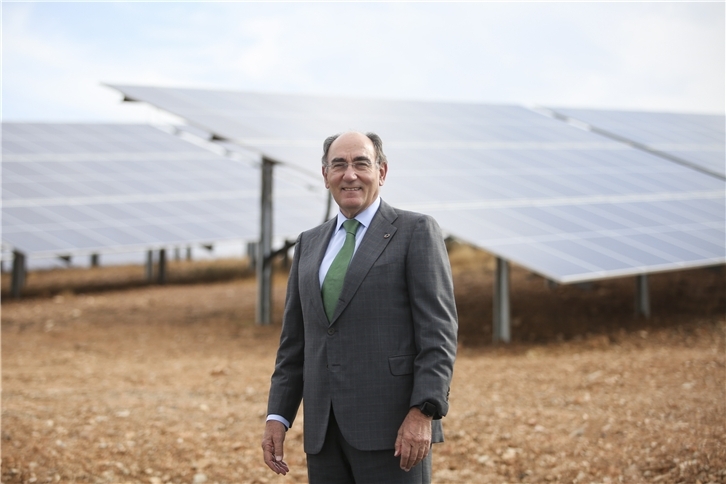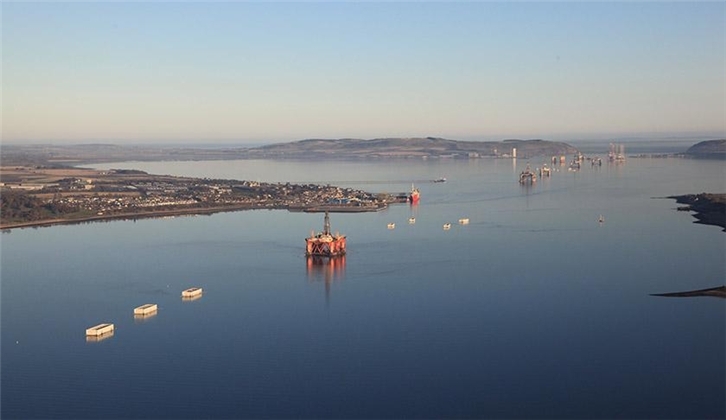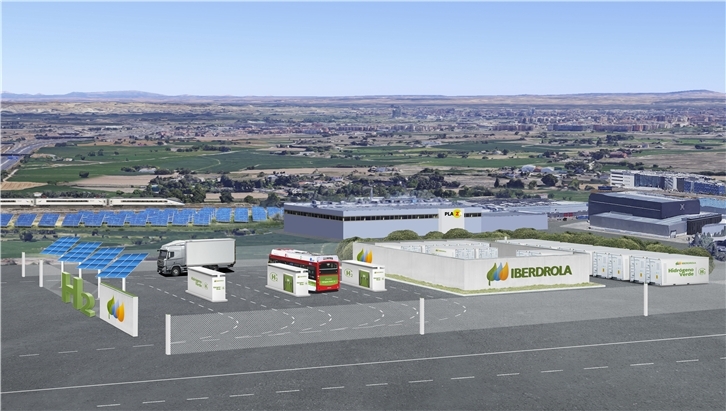News
-
13/03/2021Iberdrola refuerza su apuesta por Canarias, con 36,3 MW fotovoltaicos nuevos Iberdrola refuerza su apuesta por el mercado energético renovable en Canarias, tras conseguir el 36% de la potencia total subastada en Fuerteventura en el primer proceso de licitación de capacidad fotovoltaica dotada con fondos FEDER (SolCan). La compañía promoverá los proyectos Huriamen I y Huriamen III, de 6 y 15 MW, respectivamente, y otros 15,5 MW de las plantas fotovoltaicas Llanos Pelaos I, II, III y Blanca Solar, promovidas conjuntamente con Ingeniería y Aplicaciones Solares (Lasol) y Energy Projects & Investment Capital (Energy Capital). Las plantas se encuentran en tramitación administrativa y su puesta en marcha está prevista entre este mismo año y 2022. Su desarrollo contribuirá al proceso de descarbonización que impulsa las Islas Canarias, especialmente en Fuerteventura, una zona que forma parte de la Red Mundial de Reservas de la Biosfera y del Plan de Acción de la UNESCO, que contempla potenciar las energías renovables y combatir el cambio climático. Los resultados de la subasta alinean el compromiso de Iberdrola con la Estrategia Energética de Canarias (EECan25), que plantea alcanzar un 45% de penetración de energías renovables en el mix energético de las islas, impactado de forma muy significativa por fuentes de origen fósil. En Canarias, Iberdrola opera desde 2019 el parque eólico de Chimiche en Tenerife. Con una potencia de 18,3 megavatios (MW) y una inversión de más de 25 millones de euros, el proyecto generó durante su construcción más de 200 empleos y abastece ya de energía limpia a una población equivalente de 15.000 hogares, evitando la emisión de 33.000 toneladas de CO2 de 18 MW al año. Inversiones verdes para la promover la recuperación económica y el empleo Iberdrola está convencida que la transición energética puede actuar como agente tractor clave en la transformación del tejido industrial y en la recuperación verde de la economía y el empleo. Para ello, la compañía ha lanzado un plan de inversión histórico de 150.000 millones de euros en la próxima década -75.000 millones de euros para 2025-, con los que triplicar la capacidad renovable y duplicar los activos de redes y aprovechar las oportunidades de la revolución energética que afrontan las principales economías del mundo. Las inversiones en España se elevan a cerca de 14.300 millones de euros para 2025 y la mitad -más de 7.000 millones de euros- irán destinadas al desarrollo de nuevos proyectos renovables. Tras veinte años promoviendo la transición energética, Iberdrola es líder en energía renovable con cerca de 35.000 MW instalados; un volumen que convierte a su parque de generación en uno de los más limpios del sector energético. Con unas emisiones de grCO2/kWh que son ya dos tercios inferiores a la media europea, la estrategia de inversión en energía limpia y redes llevará a Iberdrola a ser una compañía “neutra en carbono” en Europa en 2030. READ MORE

-
10/03/2021Iberdrola presents the 2021 Iberdrola - Museum Programme of Conservation and Restoration with the Bilbao Museum of Fine Arts Since 2013 the Iberdrola - Museum Programme of Conservation and Restoration has been working to keep the Bilbao Fine Arts Museum collection in an optimal state of conservation. To achieve this, a selection of works are chosen every year that need attention and represent different chronological points and varying artistic techniques. In addition, in 2019 a new line of work was added for works of art which, though not belonging to the museum's collection, form part of the temporary exhibitions. This was the case for a selection of paintings belonging to private collections which were included in the exhibitions Ameztoy and Masterpieces of the Valdés collection. Finally, the programme is extending its mission through the training of future professionals who, thanks to the Iberdrola - Bilbao Fine Arts Museum grant, are developing their knowledge and experience in the Department of Conservation and Restoration. Work on recently acquired pieces and introductory programme In 2020 the programme continued with these lines of work except that, in addition, work has also been done on recently acquired pieces which are now on public display for the first time. Such is the case for the paintings Paisaje con pastor by Ignacio Iriarte - recently acquired thanks to the contribution from the Friends of the Museum; Playa de Sopelana and Paisaje con montañas by Juan de Barroeta; La fábrica de Pasajes by Gonzalo Chillida and Montmartre sous la neige by Jean-François Raffaëlli; and the prints by Joaquim Sunyer and Marta Cárdenas. To these can be added familiar works from the collection signed by Ángel Larroque, Remigio Mendiburu and Pablo Milicua. Separately, and with the future extension of the museum in mind, a new introductory programme has been launched to inform about the museum's architecture and the artistic heritage surrounding it through guided tours of the exterior. These are included free with entry to the museum and take place every weekend (Saturdays at 12:30 and 18:30; Sundays at 12:30; in Spanish and in Basque on the last Sunday of each month. Booking online, or on the day, at the museum box office). READ MORE

-
07/03/2021Iberdrola launches a green hydrogen scheme to produce sustainable Scotch whisky in the Highlands Iberdrola, though its subsidiary ScottishPower, has teamed up with some of the UK's main distilleries and spirits companies and the Port of Cromarty Firth to launch a green hydrogen project in the Highlands. The result will allow the whisky and spirit production industry in Scotland to develop this technology and fight climate change. The North of Scotland Hydrogen Scheme will create a state-of-the-art hub in the Cromarty Firth to produce, store and distribute renewable hydrogen to the region and other parts of the UK and Europe. One of the leading projects – whose feasibility study will be released in May – will supply Scottish distilleries with renewable hydrogen. The scheme will be funded by ScottishPower and drinks giants Glenmorangie, Whyte & Mackay and Diageo in collaboration with energy company Pale Blue Dot. They will produce electricity with electrolysers powered by 100 % clean energy from existing and future offshore and onshore wind farms along the Cromarty Firth coast. This supply of green hydrogen will enable Glenmorangie, Whyte & Mackay and Diageo to decarbonise heat production in their distilleries and malting plants close to the Cromarty Firth, replacing fossil fuels with hydrogen to produce the steam required for distilling. The scheme will boost climate neutrality and decarbonisation in Scotland, which has set its sights on becoming the industry's world leader when it comes to green hydrogen. The project furthers these companies’ strategies and actions by allowing them to work together on a competitive technology to supply green hydrogen to the distillery industry and to public services such as ports, while decarbonising their operations. There are massive opportunities in the Highlands for decarbonising industry, transport and the heating and refrigeration sectors and to export green energy to other parts of the UK and continental Europe. Scotland has the potential to become a global trailblazer in large-scale green hydrogen production. It is also important not to underestimate the massive positive effect that this technology can have for decarbonising Scotland, as well as for creating jobs and stimulating the economy. Up to 15 new offshore wind plants will be developed in the near future, a significant number of which will be built in sites at the entrance to the Cromarty Firth. The Port of Cromarty Firth's deep waters, existing facilities and proximity to an area with vast potential for renewable energy make it a strategic location for a green hydrogen plant. Not only will green hydrogen have an important role in the fight against climate change, it will also create significant economic opportunities in Scotland by reviving a port with a long history in the energy sector centre in the North Sea. It will also be an incentive for companies to guide the industrial supply chain toward a green economy with high added value. The North of Scotland Hydrogen Programme is an emblematic scheme that illustrates how collaboration between industry and the energy sector can lead to long-term sustainable solutions for areas where electrification has not arrived. The Scottish Highlands have been a hub in the renewable energies sector in the last 20 years, and they are now back at the centre of the green hydrogen revolution. Green hydrogen project in the Port of Nigg As well as this scheme, Iberdrola subsidiary ScottishPower has also come to an agreement with Global Energy Group to work together to identify processes and businesses suitable for green hydrogen technology at its Port of Nigg facilities. The green hydrogen generated at the Port of Nigg will be used to power installations, heavy machinery and vehicles used routinely on the site, and to fuel heavy-consuming high-temperature processes such as offshore wind farm component manufacturing. Scottishpower also supports decarbonisation through green hydrogen projects across the British Isles. READ MORE

-
05/03/2021“The SEAT and Volkswagen project with Iberdrola demonstrates Spain's technological potential and will contribute to the country's recovery plan” Iberdrola Chairman Ignacio Galán has expressed his delight at supporting the mega-project led by SEAT and the Volkswagen Group, an initiative that further strengthens the collaboration between the two business groups, which sealed an alliance to promote electric mobility in Spain a few months ago. The companies' executives all agreed on highlighting the need for joint work among the main actors and the opportunity to set up an ecosystem that allows our country to lead this area in Europe. Galán pointed out that “this is a country project that demonstrates Spain's technological potential and marks a milestone in public-private collaboration, the basis for the success of the Recovery and Resilience Plan.” He also recalled that Iberdrola supports and works on the “electrification of transport as an essential lever to accelerate the decarbonisation of the economy and generate activity and employment.” Iberdrola is once again putting its resources at the service of economic recovery in Spain. The company is implementing an investment plan under which 75 billion euros will be spent by 2025, and makes purchases from a value chain of more than 22,000 suppliers, which, in 2020 alone, amounted to 14 billion euros. READ MORE

-
04/03/2021Iberdrola consolidates its renewable leadership in Extremadura: 750 MW of new photovoltaic plants in the pipeline Iberdrola consolidates its renewable leadership in Extremadura and continues its investment plan in the region, with 750 MW of new photovoltaic capacity under development in the province of Cáceres, with which it will contribute to economic recovery and the demographic challenge in the region. The Tagus photovoltaic plant (380 MW) will be located in the municipality of Alcántara and will have more than 930,000 panels and 226 inverters on a fixed structure. The company expects that it will be commissioned between the end of 2022 and the beginning of 2023. The Cedillo photovoltaic plant, located between Alcántara and Herrera de Alcántara, will have installed capacity of 375 MW, with 925,680 panels and 180 fixed structure inverters. In this case, it is expected to enter into operation in 2022. With a joint investment of 420 million euros, the construction and start-up of these two photovoltaic projects will have a leverage effect on the industrial fabric and local employment, requiring the services of more than 1,700 professionals. Extremadura, at the heart of its renewable strategy Iberdrola has placed Extremadura the centre of its renewable strategy in Spain, where it will develop more than 2,600 MW of photovoltaic energy by 2023, with an investment of 2 billion euros. Following the startup of the largest photovoltaic plant in Europe, Núñez de Balboa (500 MW), Iberdrola is currently building eight renewable projects in the region, with total capacity of more than 1,300 MW. Projects include the Francisco Pizarro photovoltaic plant (590 MW), Europe's largest photovoltaic project under development, which will provide 375,000 people/year with clean energy. It will become operative in 2022 and will prevent 245,000 tonne of CO2 emissions per year, reinforcing the competitiveness of this technology for protecting the environment and mitigating global warming. It is also making progress on the Ceclavín (328 MW), Arañuelo I, II and III (150 MW), Arenales (150 MW) and two plants in Cedillo (100 MW) Iberdrola currently has more than 2,900 MW installed in Extremadura, making it the second autonomous region with the most 'green' megawatts installed by the company. With the projects planned in the region, more than 2,600 MW, Extremadura's renewable capacity will be doubled to 5,500 MW. In Spain, Iberdrola's renewable projects portfolio totals nearly 13,000 MW. Green investments to promote economic recovery and employment Iberdrola is certain that the energy transition can be a driving force in the transformation of the industrial sector and for a green recovery in the economy and the job market. The company has thus launched a historic investment plan of 150 billion euros over the next decade, 75 billion euros by 2025, to triple renewable capacity and double network assets and take advantage of the opportunities of the energy revolution that the world's leading economies are facing. Around €14.3 billion will be invested in pain up to 2025, half of which (more than €7 billion), will be spent on developing renewable energy projects, while more than 4.5 billion will go towards strengthening and digitalising its electricity grids. After twenty years promoting the energy transition, Iberdrola is a leader in renewable energy with nearly 35,000 MW installed; a volume that makes its generation park one of the cleanest in the energy sector. With CO2/kWh emissions already two thirds lower than the European average, the investment strategy in clean energy and grids will make Iberdrola a "carbon neutral" company in Europe by 2030. READ MORE

-
03/03/2021Iberdrola mobilises Aragón's first green hydrogen generation project Iberdrola is leading a project in Aragón to produce green hydrogen by building a hydrogenerator at the PLAZA Logistics Platform in Zaragoza, with 10 MW of electrolysers capable of producing and supplying green hydrogen to heavy road transport vehicles and moving towards ever-more sustainable mobility. This facility, which will be open to the public, represents an investment of more than €36 million and will include building a photovoltaic power plant for self consumption which, as well as supplying renewable energy to Iberdrola, will allow the plant to use only zero-emissions electricity. The aim of this project is to generate and supply green hydrogen to heavy road transport vehicle fleets, buses, light private and industrial vehicles, and the railway sector (with an option to serve the Zaragoza-Canfranc link and its future Pau- France connection) and projected airport use. It also includes renewable hydrogen storage and dispensing stations in nearby areas with potential for consumption in Zaragoza and Valle del Aragón. Iberdrola is leading the initiative - which it has submitted to the EU's Next Generation programme - that will be carried out in association with Aragon’s institutions and companies that have shown interest in the project. These include the regional government, Zaragoza and Jaca City Councils, the Aragón Hydrogen Foundation, the University of Zaragoza, the Aragón Automobile Cluster, the Zaragoza Area Transport Consortium and companies Zoilo Ríos, Carreras Grupo Logístico, Calvera, Inycom (Instrumentación y Componentes), Arpa and CAF, as well as PLAZA, the site on which the facility will be built. The initiative will be a massive driving force for the region, creating 1,800 direct and indirect jobs during the construction and operational phases, as well as contracts for services, materials and equipment awarded to local companies in Aragón, such as Ingeniería y Control Electrónico, Montajes Eléctricos García, Sfice Innovative Minds, Aralink Tecnologías de la Información and Efinetika. It will also improve competitiveness in these companies and boost sustainability, attract investment and encourage training and research into this type of renewable technology in universities and training centres in the region, which is one of the pioneers in the study of green hydrogen. Iberdrola is already developing several green hydrogen projects that will enable the decarbonisation of industry and transport or heavy mobility in Spain and the UK and it is also developing the value chain. The company has also submitted 53 projects to the EU's Next Generation programme, which would trigger investments of €2.5 billion to reach an annual production of 60,000 tonnes/year. In Aragón, Iberdrola manages around 500 MW in renewable projects, a figure it expects to double in the coming years, with almost 500 MW of green projects in the pipeline. These are the Peñaflor, Fuendetodos and Escatrón photovoltaic projects and a wind farm under development in Pancrudo, Teruel. All these projects have connection access and environmental analyses. What is more, the company expects to promote the development of wind and photovoltaic projects totalling 700 MW of installed capacity in different parts of the region. Green innovation to transform the industrial sector Iberdrola is certain that the energy transition can be a driving force in the transformation of the industrial sector and for a green recovery in the economy and the job market. To achieve this, it has launched an unprecedented investment plan worth €75bn for the 2020-2025 period; of which €14.3bn will be spent in Spain. In addition, the company has presented 150 initiatives to the EU's Next Generation programme - in the fields of heat electrification, floating offshore, sustainable mobility, green hydrogen, innovative renewable initiatives, smart grids, circular economy and energy storage - which would mobilise investments of €21bn and involve more than 350 small and medium-sized companies. These projects will create 45,000 jobs per year, stimulating economic growth by more than 1.5 % of GDP, improving competitiveness and the balance of payments with between 500 million and €1bn per year and helping to meet the demographic challenge by including more than €7bn euros for rural areas. These projects will have a positive impact on the competitiveness of the Spanish industrial fabric and will allow for a green recovery in the short term and, in the medium and long term, the transformation of the country, gearing it towards the sectors of the future. The developments will contribute to the green and digital transition binomial established by the European Union and are aligned with the Spanish Government’s Recovery, Transformation and Resilience Plan. READ MORE

-
03/03/2021"There is room for everyone in the green energy market, given the enormous investment opportunities offered by decarbonisation" On Wednesday 3 March Ignacio Galán took part in the session entitled "The Energy of the Future" as part of the annual CERAWeek energy conference. The chairman of Iberdrola began his presentation by reminding his audience that the current scenario, in which the main energy companies are lining themselves up for the transition towards low-carbon production, is nothing new for Iberdrola. “We have been at the forefront of this transition for the last 20 years”, he asserted. Ignacio Galán held a discussion with Patrick Pouyanné, chairman and CEO of the petrochemical company TOTAL, to whom he mentioned the entry into the renewable energy market of players from the oil and gas sectors. The chairman of Iberdrola made a point of welcoming these new participants. “There is room for everyone. Given the enormous investment opportunities offered by decarbonisation, I am pleased to see that we are all moving in the same direction” and that “the old economy is progressing towards the new one”. The meeting was chaired by Daniel Yergin, President of CERAWeek and an expert in energy and global geopolitics, who commented that businesses are reorienting their portfolios, expanding investments beyond traditional areas and adopting new technologies such as offshore wind, photovoltaic and green hydrogen. Regarding offshore wind, Galán explained that this is not new technology for the company. “We have been leaders for the last 10 years. Today it contributes some $700m to the group's EBITDA, a figure that will at least quadruple in the coming decade”, he said. “Currently, we have 1,300MW in operation, 2,600MW under construction, 9,000MW ready to start construction and a further 10,000 MW under development in Sweden, Japan, Poland and Ireland." In answer to Yergin's question, Galán also highlighted the value of this technology for its predictability, since it can function as base generation for the system in the face of the closure of coal. Galán also commented that "all forms of energy are necessary for full decarbonisation, and hydrogen is one of them”. However, he pointed out that currently all hydrogen is produced from fossil fuels “but the growth of this technology will be green”. Green hydrogen involves a greater demand for electricity, plus investments in renewable energy, networks and storage. “If all today's hydrogen were produced by electrolysis, photovoltaic and wind generation would double”, he stated. Finally, the moderator mentioned the significant presence of Iberdrola in the USA, which Galán confirmed, highlighting that “the company is present in 25 states, will invest $35bn in the country by 2025 and is backed by a high number of American investors.” READ MORE

-
02/03/2021Iberdrola plans three photovoltaic farms in the Valencia Region Iberdrola, a pioneer and a world leader in the renewable energy sector, is making progress with the formalities for its first photovoltaic projects in the Valencia region, which will have an installed capacity of 450 megawatts (MW) and represent an investment of more than 235 million euros. The company has plans to build two solar plants (PSF Ayora 1 and FV Cofrentes I) in Valle de Ayora-Cofrentes, each with an installed capacity of 200 MW, along with their energy evacuation infrastructures, such as a substation and the power lines necessary to transport the energy; and a third 50 MW facility (FV Alhorines), which is to be located in the La Encina district in Villena (Alicante). The plants planned in the region will comprise a total of almost one million photovoltaic modules and provide employment for almost 1,450 professionals during peak periods, helping to reactivate the local economy and guide companies and employment towards sectors with a future. The projects have involved reaching agreements with numerous landowners in the different areas. Once operational, these facilities will generate enough clean energy to supply the equivalent of 220,000 homes and avoid emissions of 140,000 tons of CO2/year into the atmosphere. Iberdrola manages over 2,000 MW of renewable installed power in the Valencia region by producing hydroelectricity at the Cortes-La Muela complex, the largest pumping plant in Europe. Green innovation to transform the industrial sector Iberdrola is certain that the energy transition can be a driving force in the transformation of the industrial sector and for a green recovery in the economy and the job market. The company has thus launched an unprecedented investment plan worth €75 bn for the 2020-2025 period, with the aim of doubling its renewable capacity and taking advantage of the opportunities presented by the energy revolution facing the world's main economies. Investments in Spain for the period amount to around €14.3 bn, half of which (more than €7 bn), will be spent developing new renewable energy projects, while more than 4.5 bn will go towards strengthening and digitalising its electricity grids. After 20 years promoting the energy transition in Spain, Iberdrola leads in renewable energy in the country, with installed renewable capacity exceeding 16,700 MW as of September 2020 - an amount that totals more than 35,000 MW worldwide, making its generation facilities among the cleanest in the energy sector. With CO2/kWh emissions already two thirds lower than the European average, the investment strategy in clean energy and grids will make Iberdrola a "carbon neutral" company in Europe by 2030. READ MORE








